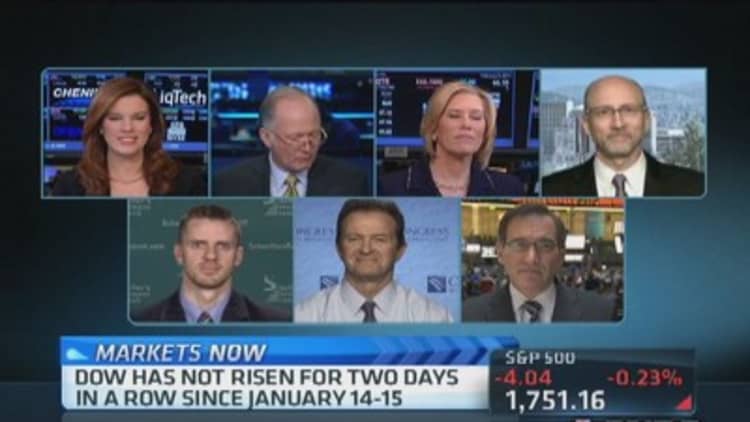Stock market volatility is back and it's back in a big way. After what was a relatively calm upward trend for stocks, all three major U.S. indexes are negative on the year, with the Dow and halfway toward a "correction." As the market struggles to find upside momentum, one of the places that we have seen a surge in value is volatility as shown by the VIX.
The VIX, or CBOE Volatility Index is a measure of shorter term expected swings in the stock market, specifically for S&P 500 companies. It uses prices on index options to derive its value. And the resulting measure is often referred to as the "fear index" or "fear gauge" among market professionals. The higher it goes, the more volatile things are expected to get.
For example, with the S&P 500 around record highs back on Jan. 15, the VIX was measuring out at around 12. Fast forward to Feb. 3, when the S&P fell by 40 points and the Dow Industrials dropped by 326 points, or over 2 percent declines on the day. The VIX closed at around 21 that day. That means that this measure of volatility jumped by 75 percent in about three weeks.
(Read more: Marc Faber: Market volatility will continue, here's why)
"Concerns surrounding a potential slowdown in Chinese growth and emerging markets caused a sharp rise in several risk metrics in late January," Barclays strategist Venu Krishna said in a note to clients, adding that demand for downside protection hit its highest levels since the euro zone crisis in mid- 2012.
The concept of "downside protection" is one of the key points about how traders manage risk in their positions and portfolios. If you own stocks and have a sizable unrealized gain, your downside risk is losing that profit and perhaps swinging to a loss. You can sell part or all of your position to lock in those gains or use the options market to buy the equivalent of insurance against a falling market. In mid-January, the VIX fell to a point where many traders considered it to be cheap. In other words, the fear index had gotten so low that there appeared to be little fear in the market. When traders view something as cheap, they tend to buy into it.
(Read more: Markets could drift as traders await jobs report)
With the cost of downside protection falling to low levels, traders used the opportunity to buy things like index and other options. Think of it as if your auto insurance company says that premiums will be slashed in half for next year, but you have to buy the whole policy in advance now. That's what insurance is—a hedge against potential downside. While futures and options may not be as easy to comprehend as other parts of the market, the emergence of exchange traded funds and notes has allowed certain investors the ability to get similar hedging benefits by just buying and selling those instruments.
For instance, the iPath S&P 500 VIX Short Term Futures exchange traded note looks to track the movements of shorter term VIX futures. Between Jan. 15 and Feb. 3, the value of this ETN surged by over 30 percent, though it's worth noting that the upside move was far less than the 75 percent move in the actual VIX Index.

That discrepancy highlights one of the big dangers of using these exchange traded products as hedging or speculative instruments. They don't always track to the actual underlying index. In many cases, they are also daily reset investments. That means that the value changes each day based upon that day's move up or down. Thus even though an underlying index may hypothetically gain 10 percent in a year, the exchange traded product may have a performance above or below that due to the daily nature of its returns.
There are other ETFs that move in the opposite direction of their underlying indexes. You can use the ProShares Short Dow 30, which moves in the opposite direction of the Dow Industrials. The ProShares Short S&P 500 moves in the opposite direction of the S&P 500. The ProShares Short QQQ goes in the opposite direction of the Nasdaq 100 index.
(Read more: Stocks: Stead as she goes...good enough for now)
That's just a handful of the plethora of ETFs that track indexes, or the inverse performance of those indexes, let alone those funds that move double or triple the amount (leveraged ETFs). Gary Thayer, chief macro strategist for Wells Fargo Advisors, believes that with regard to VIX related exchange traded products, you may not get all the benefits you're expecting.
"I think those are tools that short-term market participants use, but I don't think average investors benefit that much," he said. "You're trying to make short-term trades, and to me that always doesn't equate to success because you have to time everything very well, and I don't know that a lot of people can do that."
Brokers, financial advisors and other market professionals will tell you that these types of instruments are not buy-and-hold investments. They are meant to be tactical, or short term in nature, and not just to sock away in a portfolio. They come with a number of risks, like the ones mentioned above, and it's always prudent to check with your financial advisor before making any investing decision. Still, if you're looking to make that short term decision to insure profits in a portfolio, these are some of the products being used by active traders in lieu of more complex options and futures related strategies.
—By CNBC's Dominic Chu. Follow him on Twitter @thedomino.


